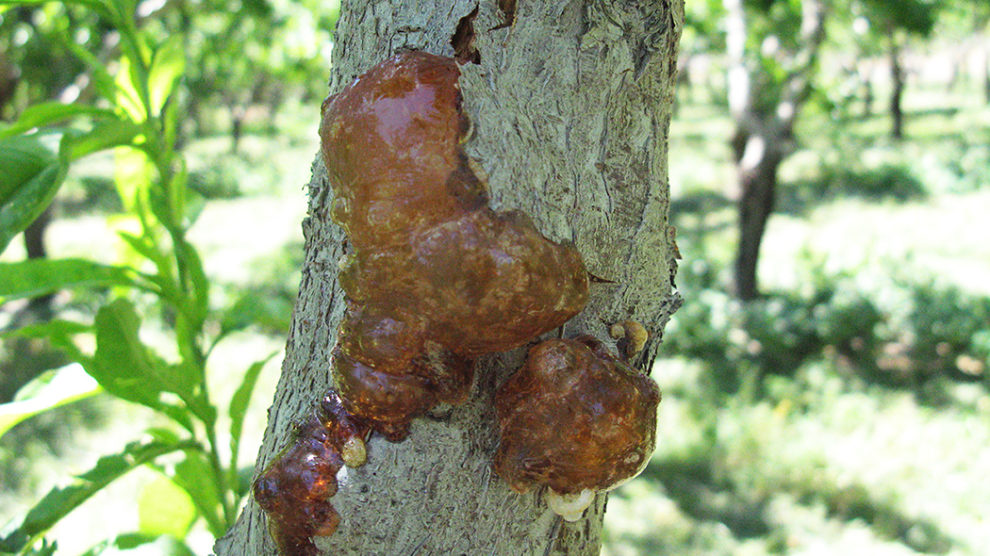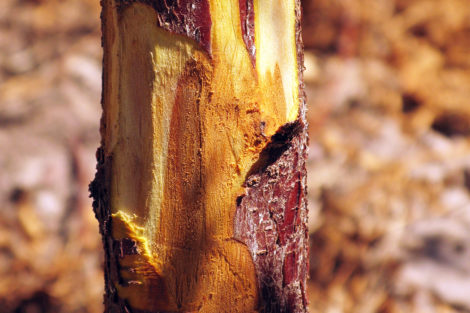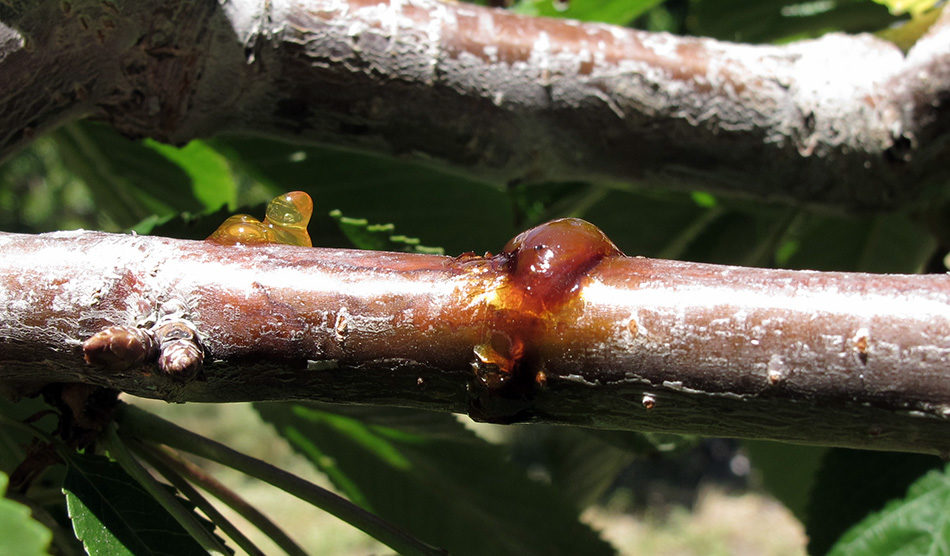Gumming on stone fruits (apricot, sweet cherry, peach/nectarine, and plum) is very common, and most evident at this time of year as the sap starts to flow. The oozing of gum is referred to as gummosis and it can be clear or dark amber in color. By the end of the summer, it will have become almost rock-hard.
The test to determine the cause of the gumming is to use a knife to scrape the outer bark away under the gum (in a small area). If the inner bark is still cream-colored (healthy), the oozing is caused by a non-living factor, and there is nothing you should do. If the inner bark is tan to brown, it is dead, and was most likely killed by a pest.
Below are possible causes of gummosis. Click on an image to open the gallery and view the captions.
Environmental Causes
Appearance: Gumming appears in random locations, or at newer pruning cuts and wounds (even tiny wounds). Color of gum starts clear to light colored but will dry to a darker amber with age. Gumming can be small droplets to excessive amounts (sweet cherry).
Description: Stone fruit trees will ooze gum in the spring due to many environmental causes. Wounds include frost cracks or sun scald, bark injury, cat scratching, deer damage, hail, etc. Other environmental causes include if the tree is planted too deep, excessive irrigation, severe summer pruning, or if the tree had a very large crop the prior year.
What You Can Do:
- No need to prune out areas of the tree with the gumming. Keep the tree healthy with optimal watering and do not prune between August and February. Remove turf around the base of the tree and replace with mulch.
Greater Peachtree Borer
Appearance: Thick, medium-amber colored gumming at the base of the tree (no higher than 8-12”). Gummosis usually appears gritty because it is mixed with frass (caterpillar excrement).
Description: Greater peachtree borer is a moth. Females lay eggs at the base of the tree starting in mid to late June. Larvae (caterpillars) feed within the crown and roots through summer until the following spring. Small trees can be killed while larger trees may become less vigorous.
What You Can Do:
- Now – grab a sturdy stick and remove (or dig into) the gumming from the base of the tree and look for the white larvae that the tree pushed out in the gum. Kill the larvae.
- Now – remove any grass, weeds, or groundcovers from around the base of the trunk, leaving the lower trunk open. The moths prefer protected areas for egg-laying, so this prevents that environment
- Late spring – Do not spray now since the adults are not active. Wait until after June 15 (for northern Utah), and use permethrin (such as Hi Yield Permethrin) once per month through Sept 15.
Borers
Appearance: Small tendrils of ooze, found in distinct locations of the tree (branches or main trunk). Color of ooze is clear initially, and turns dark amber when dry. When borers attack a tree already under great stress, very little to no gumming will occur. If the borers attack healthy trees, however, the tree will have the energy reserves to exude gum to flush out the larvae. Look for exit holes that will be a larger oval shape or a tiny round circle.
Description: Two types of borers can attack stone fruits – flatheaded and shothole borers. These will only attack weakened trees or large wound areas such as where sunscald has occurred.
What You Can Do Now:
- Now – shothole borer adults (whose exit holes are the size and shape of a BB) will be flying and laying eggs soon. If needed, apply an insecticide to cover the bark, such as a product containing permethrin (such as Hi Yield).
- All season – If borers have been identified as the cause, this is an indication that the tree is already under stress. Determine causes (water stress, nutrient, planting depth, etc.) and remedy as possible.
Cytospora Canker
Appearance: Large areas of gumming at pruning cuts, branch crotches, or anywhere along the bark. Gumming starts out medium to dark amber in color, and dries very dark. Primarily on peach, nectarine, and apricot.
Description: The most common cause of gumming on stone fruits is a disease called cytospora canker. It is caused by a fungus (Cytospora) that infects bark through an existing wound such as pruning cuts, sunscald injury, cold injury, hail, deer rubs, etc. The pathogen kills the bark and underlying wood, and the tree oozes gum at the infection site as a defensive measure.
If you scrape the bark off at an area where gumming occurs, the phloem underneath will be dead, and a cinnamon-brown color. Cytospora canker is very common in Utah’s stone fruit orchards, as well as on backyard trees.
Trees with cytospora can still produce for several years if they are kept healthy. An excellent bulletin on Preventive Control of Cytospora Canker is available from Colorado State University.
What You Can Do
- Now – remove severely affected trees from the orchard or backyard.
- During normal pruning operations (early spring) – make proper cuts (i.e., do not leave stubs or do not make “flat cuts” that remove the branch collar where healing would normally occur) and do not prune in wet weather. Pruning the Orchard
- Early spring to mid summer – Prune out infected limbs and twigs back to healthy wood. Sometimes it is not possible to remove all infected limbs. In that case, be diligent about tree health, sanitation, and regular pruning practices.
- All season – Keep trees healthy with optimal watering, mulching, nutrition, etc.
- In fall – protect the bark during winter from sunscald. Either apply white tree wrap from December to March, or paint the trunk (anytime) with 50/50 latex paint/water
Bacterial Canker
Appearance: Milky to clear light amber-colored gumming at buds, on twigs, or along branches or trunk. As gum dries, it darkens in color. In Utah, this is primarily associated with sweet cherry.
Description: Gumming that occurs on sweet cherry that is also associated with wilting or dying limbs is likely bacterial canker (Pseudomonas syringae). Like Cytospora, it infects bark through an existing wound such as pruning cuts, sunscald injury, cold injury, hail, deer rubs, etc., and kills the bark and underlying tissue, stopping the flow of water.
What You Can Do
- Now – remove severely affected trees from the orchard or backyard.
- Now – Prune out infected limbs and twigs back to healthy wood. Sometimes it is not possible to remove all infected limbs. In that case, be diligent about tree health, sanitation, and regular pruning practices.
- All season – Keep trees healthy with optimal watering, mulching, nutrition, etc.
- In fall – protect the bark during winter from sunscald. Either apply white tree wrap from December to March, or paint the trunk (anytime) with 50/50 latex paint/water























